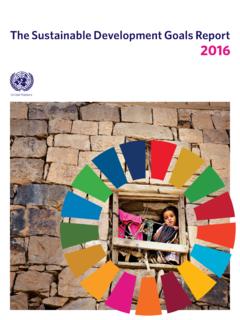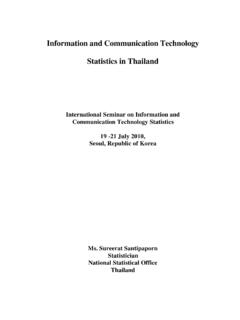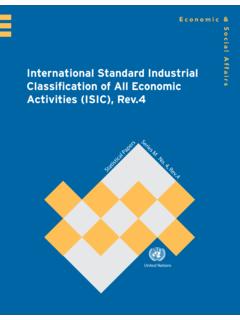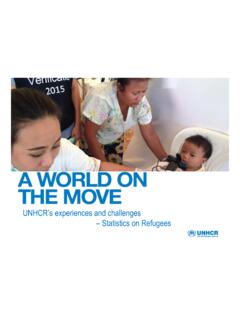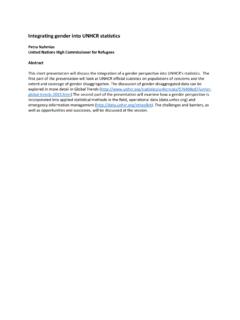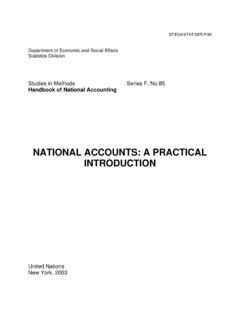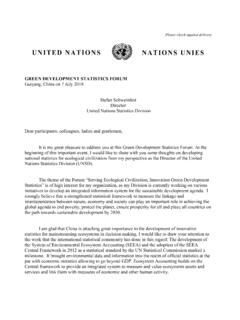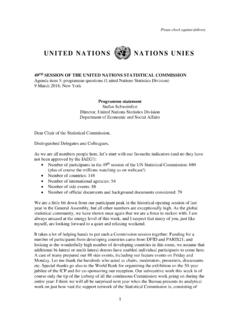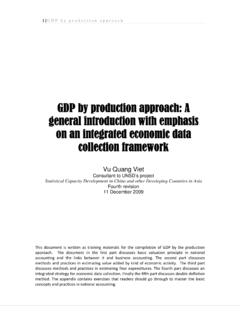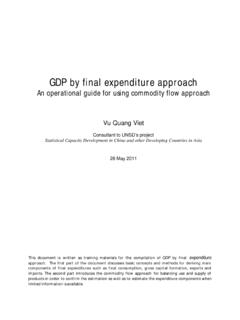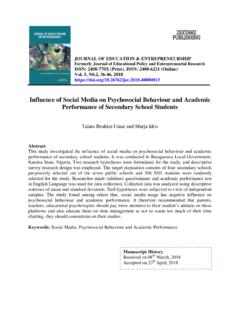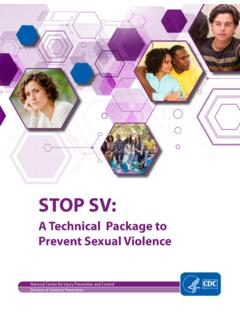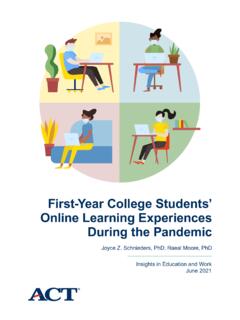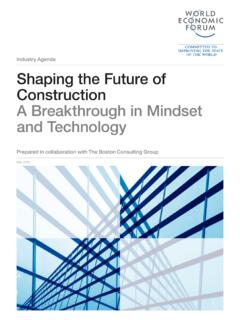Transcription of Education Equality in the Philippines - United Nations
1 Republic of the Philippines Philippine Statistics Authority Education Equality in the Philippines Patricia Anne R. San Buenaventura Chief Statistical Specialist Statistical Standards Division Standards Service Philippine Statistics Authority International Workshop on Data Disaggregation for the Sustainable Development Goals 30 January 2019. Source: The Philippine Star (2018). 1. Republic of the Philippines Philippine Statistics Authority Php B. 2019 Budget for Key Education Programs K-12 Basic Education Facilities Free Tertiary 30%. Education 44% (Php B). (Php 51 B). 2% Additional (Php B). Teaching 24% Positions (Php B). Filling Existing Unfilled teaching Positions Php B 2. Republic of the Philippines Philippine Statistics Authority The Philippine Educational System Basic Education Technical Higher Education Vocational 1.
2 Kindergarten/ Early Associate degree/Short- childhood Education Education and cycle tertiary Education 2. Elementary/ Primary Training (TVET) Bachelor level Education Education Advanced/Post-Graduate 3. Secondary/Junior and Post-Secondary o Post-baccalaureate senior High Schools Non-Tertiary level Education 4. Alternative learning Education o Master level system (special needs Associate Education and out-of-school degree/Short-cycle o Doctorate level learners) tertiary Education Education RA10931, Universal Access RA10533, EO 358, s. 2004 to Quality Tertiary Enhanced RA 7796, Technical Education Act RA10678, Unified Student Basic Education and Skills Financial Assistance Education Development Act of System for Tertiary 1994 Education (UniFAST) Act Act of 2013 3. Republic of the Philippines Philippine Statistics Authority 2013 Functional Literacy, Education and Mass Media Survey Printed in English, 7 languages and 24 dialects 20,695 respondent households; 61,410 respondent individuals Two forms: Household questionnaire Demographic Characteristics (Basic) Literacy and Education Employment Characteristics Household Characteristics/Amenities Individual questionnaire 4.
3 Republic of the Philippines Philippine Statistics Authority 2013 Functional Literacy, Education and Mass Media Survey Individual questionnaire Basic numeracy Reading and Writing 5. Republic of the Philippines Philippine Statistics Authority 2013 Functional Literacy, Education and Mass Media Survey Individual questionnaire Numeracy and calculations Reading comprehension Writing a sentence Being a Filipino Human rights Life skills Community thinking Access to TVET, computers, TV, movies, etc. Sports activities FLEMMS to be conducted in 2019 (provided that the budget is approved) 6. Republic of the Philippines Philippine Statistics Authority Girls/females outnumber boys/males in enrollment. In 2017, million kids were enrolled in kindergarten, elementary, junior and senior high schools in the public and private schools, state universities and colleges and local universities and colleges.
4 Enrollees in TVET courses reached million in 2016 . Females comprised of the total number of enrollees, while male enrollees comprised of the total. (Table 2). The number of enrollees in HEIs in AY 2017-2018 reached million. of these enrollees were females. were males. The number of graduates in HEIs in AY 2016 -2017 was 703,327. were females. 41% were males. Sources: Department of Education , Technical Education And Skills Development Authority and Commission on Higher Education 7. Republic of the Philippines Philippine Statistics Authority Table 1. Key Statistics on Education Indicators by Sex Indicator Both Males Females Sexes Primary net enrollment rate ( 2016 ) Secondary net enrollment rate ( 2016 ) Primary completion rate (2015) Secondary completion rate (2015) Primary dropout rate (2015) Secondary dropout rate (2015) Proportion of pupils starting grade 1 who reach last grade of primary Education (2015).
5 Proportion of students starting grade 7 who reach grade 10 (2015). Source: Department of Education 8. Republic of the Philippines Philippine Statistics Authority Table 1. Key Statistics on Education Indicators by Sex (cont'd). Indicator Both Males Females Sexes Basic Literacy Rate of 15-19 year olds (2013) Basic Literacy Rate of 10 year olds and over (2013) Functional Literacy Rate of 15-19 year olds (2013) Functional Literacy Rate of 10-64 year olds (2013) Ratio of girls to boys in primary Education ( 2016 ) Ratio of girls to boys in secondary Education ( 2016 ) Ratio of females to males in tertiary Education ( 2016 ) Sources: Philippine Statistics Authority (2013 Functional Literacy, Education and Mass Media Survey), Department of Education and Commission on Higher Education 9. Republic of the Philippines Philippine Statistics Authority Significantly more females were getting advanced degrees than males.
6 Source: Commission on Higher Education Table 2. Program Level Male Female Grand Total Higher Pre-Baccalaureate 64,787 45,555 110,342. Education Baccalaureate 1,179,335 1,439,421 2,618,756. Enrollment Post Baccalaureate 3,428 7,776 11,204. by Program Level and Masters 66,878 147,662 214,540. Sex: AY 2017- Doctorate 10,572 16,389 26,961. 18 Grand Total 1,325,000 1,656,803 2,981,803. Program Level Male Female Grand Total Table 3. Higher Education Pre-Baccalaureate 37,705 34,303 72,008. Graduates by Baccalaureate 238,614 357,643 596,257. Program Level Post Baccalaureate 973 2,302 3,275. and Sex: AY. Masters 9,617 18,956 28,573. 2016 -17. Doctorate 1,209 2,005 3,214. Grand Total 288,118 415,209 703,327. 10. Republic of the Philippines Philippine Statistics Authority There were more female out-of-school children and youth than males.
7 Table 4. Percentage of OSCY Among Family Members 6 to 24 Years Old by Sex, 2017. Distribution of OSCY by Sex Main Reason for Not Sex and Age Group Attending School Lack of personal Male interest Marriage/family Female matters million OSCYs in 2017. 11. Source: 2017 Annual Poverty Indicators Survey (Philippine Statistics Authority). Republic of the Philippines Philippine Statistics Authority One-half of OSCYs belong to families whose income fall at the bottom 30 percent based on their per capita income. Table 5. Percent Distribution of OSCY by Per Capita Income Decile and Sex: Philippines , 2017. Both Sexes Decile Male Female Both Sexes (Cumulative). Number of OSCYs (in '000) 1,311 2,262 3,573. First Decile Second Decile Third Decile Fourth Decile Fifth Decile Sixth Decile Seventh Decile Eight Decile Ninth Decile Tenth Decile Total Source: 2017 Annual Poverty Indicators Survey (Philippine Statistics Authority) 12.
8 Republic of the Philippines Philippine Statistics Authority Performance indicators on Education vary across regions. ARMM lags behind all other regions in most Education indicators. Figure 2. Net Enrollment Rates by Region and Educational Level: SY 2017-2018. Elementary Secondary Region I Region I Region II Region II Region III Region III CALABARZON CALABARZON MIMAROPA MIMAROPA Region V Region V Region VI Region VI Region VII Region VII Region VIII Region VIII Region IX Region IX Region X Region X Region XI Region XI Region XII Region XII CARAGA CARAGA ARMM ARMM CAR CAR NCR NCR Source: Department of Education 13. Republic of the Philippines Philippine Statistics Authority Table 6. Key Statistics on Education Indicators by Region Student- Basic Literacy Functional Pupil-Teacher Teacher Ratio Primary Secondary Primary Secondary Rate of 15-19 Literacy Aged Ratio in in Secondary Completion Completion dropout rate dropout rate year olds 15-19 years Primary Schools Region Rate (2015) Rate (2015) (2015) (2015) (2013) old (2013) ( 2016 ) ( 2016 ).
9 Philippines 84 74 32 26. NCR CAR 70 Region I Region II 89 Region III 7 99 99 Region IV-A Region IV-B Region V Region VI Region VII 33 Region VIII - - 26. Region IX Region X 84 3 8 Region XI Region XII 73 Caraga ARMM 64 Sources: Philippine Statistics Authority (2013 Functional Literacy, Education and Mass Media Survey), and 14. Department of Education Republic of the Philippines Philippine Statistics Authority Gap between the sexes in terms of number was noted in tertiary level. Figure 3. Ratio of Girls to Boys (Females to Males) by Level and Region: 2016 . NCR CAR Region I Region II Region III Region IV-A MIMAROPA Region V Region VI Region VII Region VIII Region IX Region X Region XI Region XII Caraga ARMM Primary Education Secondary Education Tertiary Education 15. Equal to 1 Less than 1 Greater than 1 Sources: Commission on Higher Education and Department of Education Republic of the Philippines Philippine Statistics Authority Basic Education : Alternative Learning System It is a parallel learning system in the Philippines that provides a practical option to the existing formal instruction.
10 When one does not have or cannot access formal Education in schools, ALS is an alternate or substitute. Basis: 1987 Philippine Constitution Governance Act for Basic Education otherwise known as the Republic Act 9155. Sources: Department of Education , and World Bank 16. Republic of the Philippines Philippine Statistics Authority Basic Education : Alternative Learning System The number of ALS learners reached by the program was 641,584 in 2017. The budget for ALS has remained at less than 1% of the public basic Education spending. Female participants consistently outperformed their male counterparts, and urban participants passed the A&E. exam at a higher rate than rural participants. Sources: World Bank (2018) 17. Republic of the Philippines Philippine Statistics Authority Education and Special Groups: SY 2017-18.
